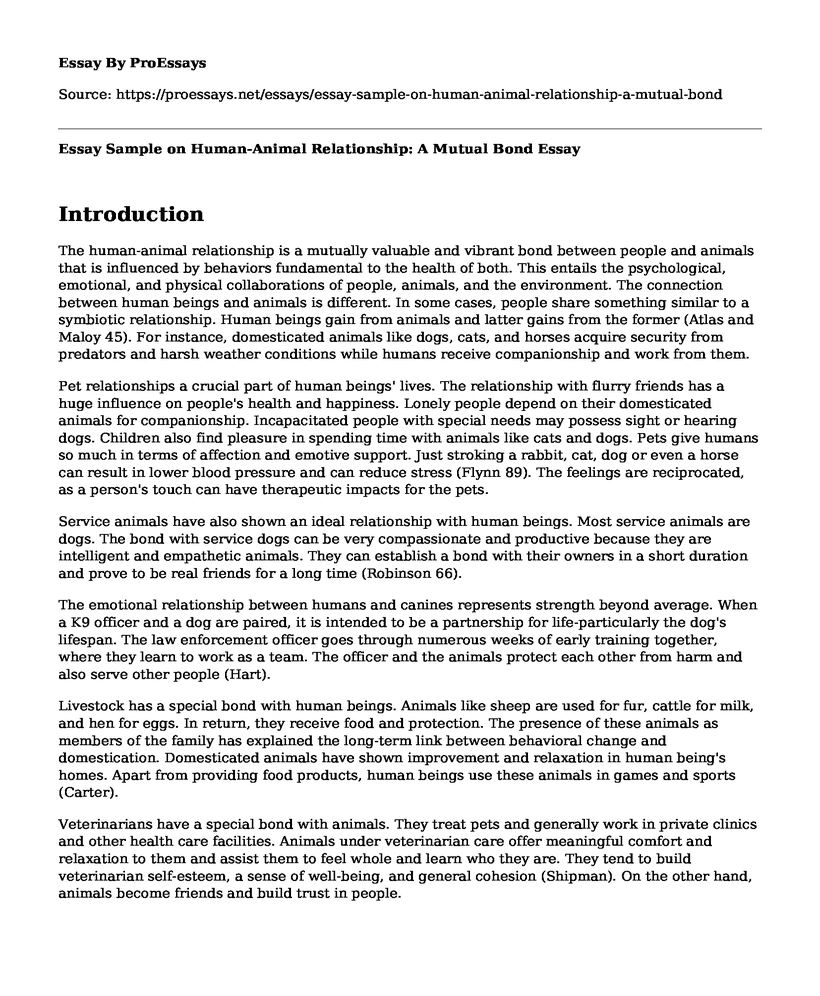Introduction
The human-animal relationship is a mutually valuable and vibrant bond between people and animals that is influenced by behaviors fundamental to the health of both. This entails the psychological, emotional, and physical collaborations of people, animals, and the environment. The connection between human beings and animals is different. In some cases, people share something similar to a symbiotic relationship. Human beings gain from animals and latter gains from the former (Atlas and Maloy 45). For instance, domesticated animals like dogs, cats, and horses acquire security from predators and harsh weather conditions while humans receive companionship and work from them.
Pet relationships a crucial part of human beings' lives. The relationship with flurry friends has a huge influence on people's health and happiness. Lonely people depend on their domesticated animals for companionship. Incapacitated people with special needs may possess sight or hearing dogs. Children also find pleasure in spending time with animals like cats and dogs. Pets give humans so much in terms of affection and emotive support. Just stroking a rabbit, cat, dog or even a horse can result in lower blood pressure and can reduce stress (Flynn 89). The feelings are reciprocated, as a person's touch can have therapeutic impacts for the pets.
Service animals have also shown an ideal relationship with human beings. Most service animals are dogs. The bond with service dogs can be very compassionate and productive because they are intelligent and empathetic animals. They can establish a bond with their owners in a short duration and prove to be real friends for a long time (Robinson 66).
The emotional relationship between humans and canines represents strength beyond average. When a K9 officer and a dog are paired, it is intended to be a partnership for life-particularly the dog's lifespan. The law enforcement officer goes through numerous weeks of early training together, where they learn to work as a team. The officer and the animals protect each other from harm and also serve other people (Hart).
Livestock has a special bond with human beings. Animals like sheep are used for fur, cattle for milk, and hen for eggs. In return, they receive food and protection. The presence of these animals as members of the family has explained the long-term link between behavioral change and domestication. Domesticated animals have shown improvement and relaxation in human being's homes. Apart from providing food products, human beings use these animals in games and sports (Carter).
Veterinarians have a special bond with animals. They treat pets and generally work in private clinics and other health care facilities. Animals under veterinarian care offer meaningful comfort and relaxation to them and assist them to feel whole and learn who they are. They tend to build veterinarian self-esteem, a sense of well-being, and general cohesion (Shipman). On the other hand, animals become friends and build trust in people.
Conclusion
Conclusively, human and animal relationship ensures that they both benefit from each other. Human beings tend to benefit psychologically, emotionally and physically from the animals and vice versa. Pet animals provide people with company and comfort. On the other hand, pets benefit from protection and food. Service animals have a mutual relationship with the people they care for. Livestock provides human beings with the product and in return, they receive security and food. Veterinarians share an exceptional relationship with the pets they treat. They improve the self-esteem and emotions of the animal.
Works Cited
Atlas, Ronald M, and Stanley Maloy. One Health: People, Animals, and the Environment. Washington, D.C: American Society for Microbiology, 2014. Print.
Carter, Marie. Why the relationship between owners and pets is always an unconditional one. Thursday 1, 2016. https://www.independent.co.uk/property/house-and-home/pets/why-pets-unconditionally-love-their-owners-dogs-cats-a7447406.html Accessed October 7, 2019.
Flynn, Clifton P. Social Creatures: A Human and Animal Studies Reader. New York: Lantern Books, 2008. Print.
Hart, A. Lynette. How the human-animal bond of clients affects veterinary practice (Proceedings). April 01, 2009. http://veterinarycalendar.dvm360.com/how-human-animal-bond-clients-affects-veterinary-practice-proceedings Accessed October 7, 2019.
Robinson, I. The Waltham Book of Human-Animal Interaction: Benefits and Responsibilities of Pet Ownership. Oxford: Pergamon Press, 2013. Internet resource.
Shipman, Pat. Why do we have such a close relationship with animals? September 27, 2017. https://www.newscientist.com/article/mg23531450-500-why-do-we-have-such-a-close-relationship-with-animals/ Accessed October 7, 2019.
Cite this page
Essay Sample on Human-Animal Relationship: A Mutual Bond. (2023, Feb 23). Retrieved from https://proessays.net/essays/essay-sample-on-human-animal-relationship-a-mutual-bond
If you are the original author of this essay and no longer wish to have it published on the ProEssays website, please click below to request its removal:
- Should Genetically Modified Foods Be Labeled as Such?
- Essay Example on Explore Animal Diversity in Tanzania & Costa Rica: Bird Watching Hotspots
- Essay Example on Auditory System: Sensory Organs, Motion Tasks, and Cortex
- Essay Example on Primate Evolution: Changes in Locomotion & Body Structure
- Digestive System: Maintaining Homeostasis - Essay Sample
- Gene Patents: Unlawful & Unjust? - Essay Sample
- Free Paper on Genetic Engineering: Creating an Improved Version of Humans







